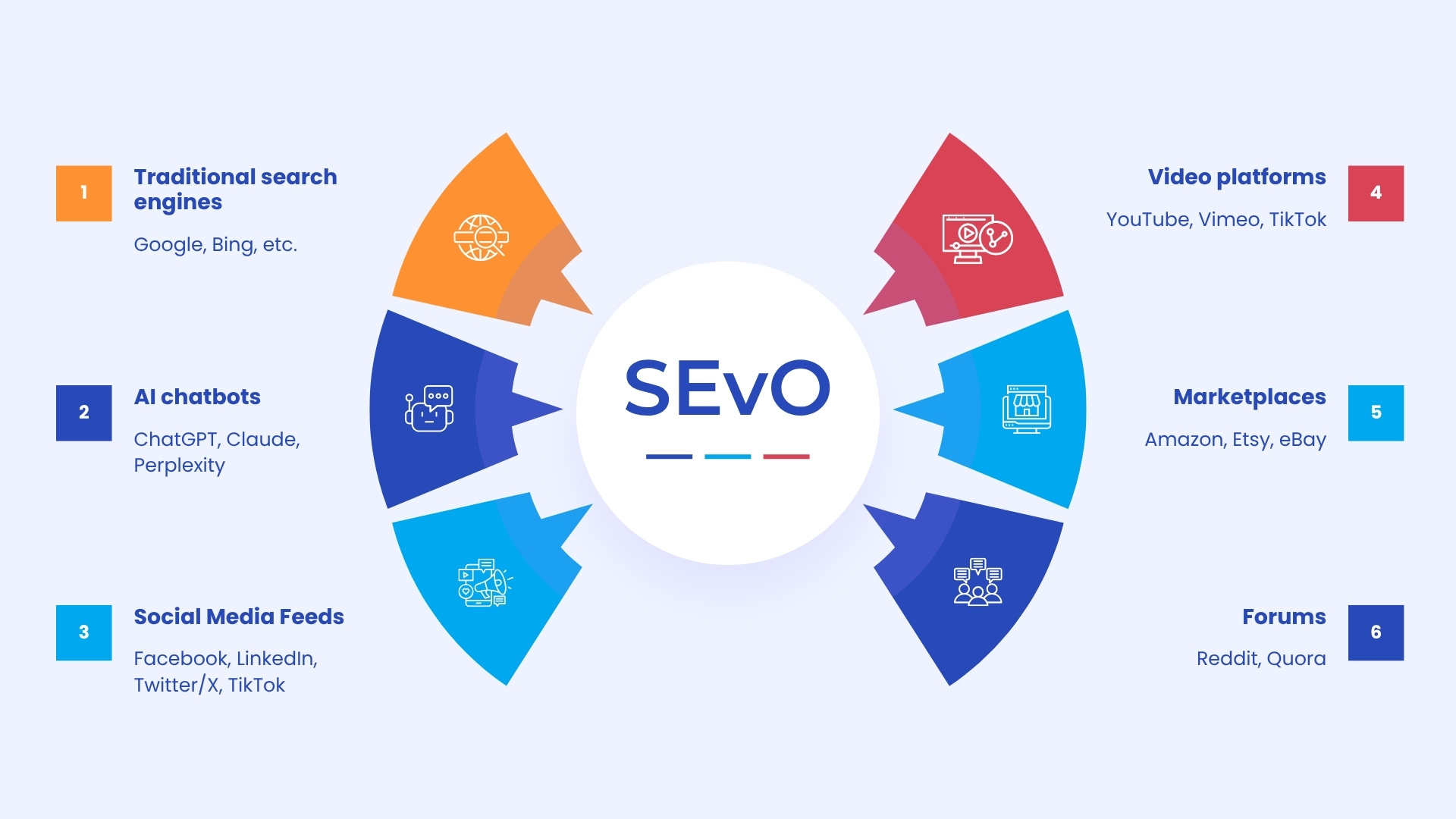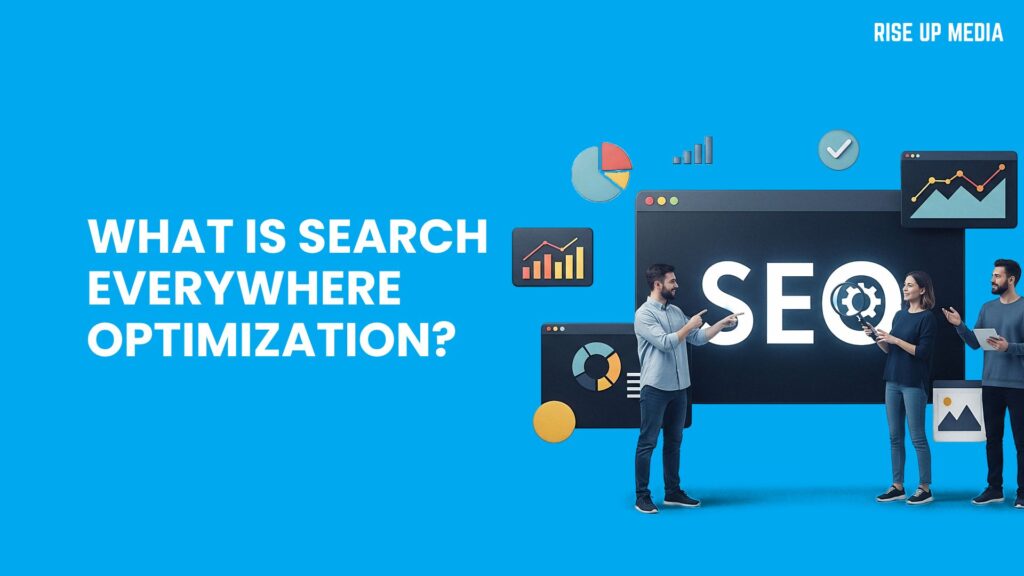When people want to know something, they’re not just going to Google. They’re finding answers on TikTok, Reddit, YouTube, ChatGPT, and other AI assistants.
If you’re not showing up on these channels, you’re being edged out of the market, fast.
Search Everywhere Optimization is helping brands meet users where they actually search, not where they used to. That means optimizing for AI summaries, social algorithms, video search intent, and even conversational searches.
Let’s break down this new era of search and how you can align content structure, metadata, and strategy to make your brand more discoverable.
TL;DR
- Search Everywhere Optimization (SEvO) moves beyond Google to include TikTok, YouTube, Reddit, ChatGPT, and more.
- Each platform has its own rules, from watch time on YouTube to trending audio on TikTok.
- Success means adapting to each channel’s ranking signals.
- To win at SEvO, use platform-specific keywords, formats, and metadata; what works on Google won’t automatically work on Instagram or X.
What Is Search Everywhere Optimization?

Search Everywhere Optimization (SEvO) is a strategy that makes your content discoverable across every search platform people use to find information.
These include:
- Traditional search engines (like Google and Bing)
- AI chatbots (like Claude and ChatGPT)
- Social media feeds
- Video platforms
- Marketplaces
- Forums
Every channel has its own algorithm and ranking factors. Instead of chasing just one of them (like most brands do with Google), SEvO zeroes in on adaptable, multi-format content that shows up everywhere.
How Search Everywhere Optimization Works
Search Everywhere Optimization strategically uses keywords, content placement, backlinks, engagement, and quality signals to rank content on your chosen platforms.
Sounds like traditional SEO.
The difference is that SEvO expands the framework to include platform-specific signals, such as watch time on YouTube or quick, verbatim answers on ChatGPT and Claude.
Let’s break it down:
- AI search engines (like ChatGPT or Perplexity) prioritize well-structured, clearly sourced content. If your brand isn’t producing authoritative, first-party insights, you won’t get cited.
- Social platforms like TikTok and Instagram use engagement metrics, such as watch time, shares, and comments. Optimization here means quick hooks, native formats, and trending topics.
- Video platforms like YouTube value click-through rate, viewer retention, and metadata. Thumbnails, titles, and timestamps matter as much as keywords.
- Marketplaces (e.g., Amazon) reward sales velocity, reviews, and relevance. Optimizing product listings combines SEO with CRO.
There’s no one-size-fits-all strategy with SEvO. Knowing the rules for each platform lets you win on multiple fronts simultaneously.
Platforms You Should (Probably) Optimize For
While most brands are going deep on Google, now’s the perfect time to go wide on SEvO. Here are the platforms becoming part of the larger search ecosystem.
Google (& Bing)
Traditional search isn’t disappearing. Google processes 13.7 billion searches each day and captures over 90% of the global search engine market share.
Google’s also iterating for the next era of search, with its AI overviews and AI mode. Other search engines are following a similar path:
- Bing’s Copilot search creates AI-generated summaries and link recommendations.
- Yandex uses AI in its search engine.
- DuckDuckGO has launched Duck.ai, offering the same level of privacy as its search engine.

Each search engine gives you a new opportunity to show up in front of your audience.
AI Search Engines
AI tools like ChatGPT, Perplexity, and Google AI Mode pull from indexed pages and synthesize answers. To show up, you need a strong online presence and well-structured, clearly sourced content.
Decentralized Social Media
Platforms like Mastodon, Farcaster, and Lens Protocol might not have massive reach yet. But they’re shaping the future of open, algorithm-free content discovery.
These networks prioritize authenticity and user trust, making them valuable for niche authority and visibility among early adopters.
YouTube
YouTube is the second-largest search engine, with 122 million daily active users. In many cases, users turn to YouTube before Google for tutorials, reviews, and how-tos.
Ranking here means optimizing for video SEO. Elements like titles, thumbnails, metadata, and retention matter.

Here’s what optimizing YouTube content for SEvO looks like:
- Focus on watch time: Hook viewers early, deliver value quickly, and structure content to keep them engaged through to the end.
- Use target keywords: Include them in the video file name, title, description, tags, transcripts, and even spoken dialogue. YouTube’s algorithm crawls all text-based elements to understand your content.
- Write clickable titles & descriptions: Keep titles under 60 characters and front-load descriptions with keywords and value. Include a clear CTA and relevant hashtags.
- Add custom thumbnails: High-quality, eye-catching thumbnails increase click-through rates and help your video stand out in search results.
- Leverage chapters, tags & playlists: Use timestamps to improve user experience and SEO. Group related videos into playlists to increase session time.
- Optimize for engagement: Include CTAs in the video and pinned comments. Use cards and end screens to guide viewers to more content.
Essentially, you’ll optimize YouTube videos like you would for Google, but taking into account the unique features and metrics that video SEO offers.
X
Real-time relevance drives discovery on X. Users search for news, expert takes, viral news, and trending topics. X surfaces content through conversation and authority, not just algorithms.

Optimizing here means timely posting, strong hashtags, and thought leadership.
Your goal should be to position your brand in the middle of conversations. Be prepared to participate in them, too.
Here’s how to optimize your presence on X to increase discoverability:
- Create user-first content: Mix short, punchy posts with long-form insights. Hot takes grab attention while value-packed threads build authority.
- Post consistently: Regular engagement boosts algorithmic reach. Avoid erratic posting schedules.
- Create SEO-friendly profiles: Use keywords and hashtags in your bio, username, and posts. Treat your profile like a landing page: clear, searchable, and audience-aligned.
- Add a hashtag strategy: Use relevant, searchable hashtags, not just trendy ones. These make your content easier to find via X search.
- Engagement matters: Comments, retweets, and DMs signal relevance. Build relationships by starting conversations, not just pushing content.
- Visuals win: Tweets with images or videos consistently outperform plain text.
Instagram’s Explore and Reels features have helped it evolve into its own category of search. People come here to discover products and lifestyle ideas, advice, or anything that will enrich their lives.
Here’s what optimization on Instagram looks like:
- Nail your niche: Find what resonates with your audience. Explore hashtags to see what’s trending in your space and test different content styles, like photos, Reels, carousels, or tutorials.
- Leverage Instagram Insights: Use analytics to find your best posting times, top-performing formats, and most engaged demographics. Look for patterns that inform your strategy.
- Ask your audience: Use captions, Stories, polls, and comments to engage directly and learn what your followers want more of. Tailor content based on feedback.
- Study successful creators: Analyze top accounts in your niche to understand what’s working. Don’t copy, but adapt ideas to fit your brand and voice.
- Focus on intention: Every post should serve a purpose. Ask “why?” before you hit publish: Why does this matter to your audience? Why will they care?
Success comes from clean visuals, consistent branding, and content that rides the algorithmic waves, such as trending audio or hashtags.
TikTok
TikTok has become a go-to search tool, particularly for Gen Z. Users search for questions, product names, and how-to queries, expecting answers in short, engaging videos.
The three biggest ranking factors are:
- User interactions: Engagement metrics, such as watch time, likes, shares, and favorites, influence visibility. Posting when your audience is most active improves results.
- Video details: Captions, hashtags, on-screen text, spoken keywords, and trending sounds all help TikTok understand and surface your content.
- Device and account settings: Language, location, and preferences shape what users see, but weigh less than content and interaction signals.
Winning here requires content that hooks fast, provides value, and aligns with trending formats. Include keywords in captions, dialogue, and on-screen text. You can use TikTok’s autocomplete to find high-volume search terms.
Community Forums
Places like Reddit, Pinterest, Quora, and other niche-specific forums are high-interest platforms. Users seek real-world experiences and advice.
Showing up means contributing real value through comments, AMAs, or linking to helpful content. It’s high-trust, high-impact SEvO.
Bonus Tip: Content on most of these platforms also has the potential to show up in traditional search results!
Step-by-Step: How to Optimize for Search Everywhere
You don’t need to be everywhere at once, but your content does. You want to show up where your audience searches, and that means creating smart, targeted content tailored for each platform.
Let’s break down how you can build a strategy that works across AI, social, search, and video (without losing your mind in the process).
Identify the Buyer Persona to Target
Knowing who you’re talking to helps you determine where to post your content. For example, are they scrolling TikTok, Googling product comparisons, or asking ChatGPT for advice?
Knowing your target audience’s age, interests, search habits, and the platforms they use helps you create an intentional content strategy.
Do Platform-Specific Keyword Research
Google Keywords don’t always translate to IG, TikTok, and X. To find relevant keywords for your platforms, find hints through the search bar’s autocomplete.

Reddit threads and ChatGPT prompts can also help you find what people are actually looking for.
Develop a Content Roadmap
Your content road map should include two things:
- Content that solves real problems for your audience
- Content developed for the right channel
A how-to video goes to YouTube. A bold industry opinion works for LinkedIn or X.
Find this alignment between demand and format, and you’ll have a better chance of showing up in the right places.
Create and Optimize Content
Use the keywords you found in titles, captions, video scripts, hashtags, and metadata, whatever your platform allows.
Let’s look at some examples:
TikTok
- Titles appear in the thumbnail, so make it bold, clear, and curiosity-driven.
- For captions, use relevant keywords and 3-5 smart hashtags
- TikTok algorithms scan spoken words and on-screen text, so say your keywords out loud.
YouTube
- Front-load the title with target keywords, keeping it under 60 characters.
- Use the description for keyword variations, CTAs, and timestamps.
- Tags are still useful for discoverability and related content signals.
- For the thumbnail, choose high contrast, human faces, and minimal text.
- For Reels: Use trending audio, short keyword-driven captions, and bold on-screen hooks.
- For Posts: Include a strong caption with searchable hashtags and use alt text for SEO.
- For Stories: Great for polls, quick CTAs, and driving profile clicks.
- Article titles get indexed by Google. Treat them like blog post headlines.
- For posts, use 2–3 line hooks up top to stop the scroll and include relevant hashtags at the end.
- If using documents or carousels, slide titles and descriptions matter. Use keywords strategically.
X (Twitter)
- Tweets: Pack a punch in 280 characters.
- Threads: Use the first tweet like a headline. Each follow-up should add value, not fluff.
- Alt text: Don’t sleep on this; it helps with accessibility and search.
AI Search Engines (ChatGPT, Perplexity, Google SGE)
- Write source-worthy content: Answer common questions clearly and back with first-party data.
- Use headings & structure: Apply H1s, H2s, bullet points, and concise paragraphs; bots love clarity.
- Include author bylines & citations: Build trust signals for EEAT and improve inclusion in AI summaries.
Publish Content
Drop your content when your audience is active.

Source: Sprout Social
Make sure you’re following each platform’s best practices:
- EEAT (Experience, Expertise, Authoritativeness, Trustworthiness) for Google
- Answer Engine Optimization (AEO) for AI tools
- Trend alignment for social
Do Backlinks, Citation, and Mention Outreach
If you want reach outside your own channels, just ask for it.
Pitch your content to journalists, creators, podcast hosts, and forums. Get backlinks to your site and mentions from trusted voices. This builds authority and helps your content surface across platforms.
Measure and Adjust
SEvO requires you to experiment, measure, and repeat.
Track what’s working and what’s flopping. Look at engagement, watch time, click-through rates, shares, AI citations, whatever matters most on each channel. Then tweak your strategy and do it all over again.
Start Search Everywhere Optimization Today!
Search is everywhere now. If your strategy is still stuck in the “rank on Page One” mindset, you’re missing where your audience actually lives.
SEvO is about being intentional, strategic, and platform-aware. Rise Up Media can help you navigate this new era of search, with a focus on building authority, trust, and reach that no single algorithm update can take away. Get in touch to learn more.
FAQs
Does SEO only apply to Google?
Not anymore. SEO now applies to multiple platforms, such as AI tools, social media, video, and marketplaces. Each has its own search behavior and algorithm to understand. To stay visible, you need to optimize content for where your audience actually searches, not just where they used to.
Is there a future for SEO?
Yes, but it’s evolving fast. SEO is shifting from keyword-centric tactics to multi-platform visibility strategies, with a focus on user intent, content structure, and channel nuance. Success now depends on how well you understand user intent and each channel’s unique ranking signals.
What’s replacing SEO?
Nothing is replacing SEO entirely, but it’s expanding into “Search Everywhere Optimization” (SEvO), where brands optimize for visibility across AI, social, video, and more. SEvO focuses on making content discoverable across all major platforms, from AI assistants to social media. Instead of only optimizing for Google, brands now need strategies that work across an entire ecosystem of search engines and algorithms.
Is Google doing away with SEO?
No, but it’s changing the rules. With features like AI Overviews and SGE (Search Generative Experience), Google is prioritizing concise answers and authoritative sources, so traditional SEO tactics alone won’t cut it. This means brands need to focus more on content quality, structure, and credibility to show up.
Is there a better alternative to Google search?
For some queries, yes. For product reviews, how-tos, or niche questions, users often turn to YouTube, TikTok, Reddit, or AI tools like ChatGPT and Perplexity. These platforms sometimes deliver faster or more relevant answers than Google. Smart brands show up on all of them to cover their bases.




